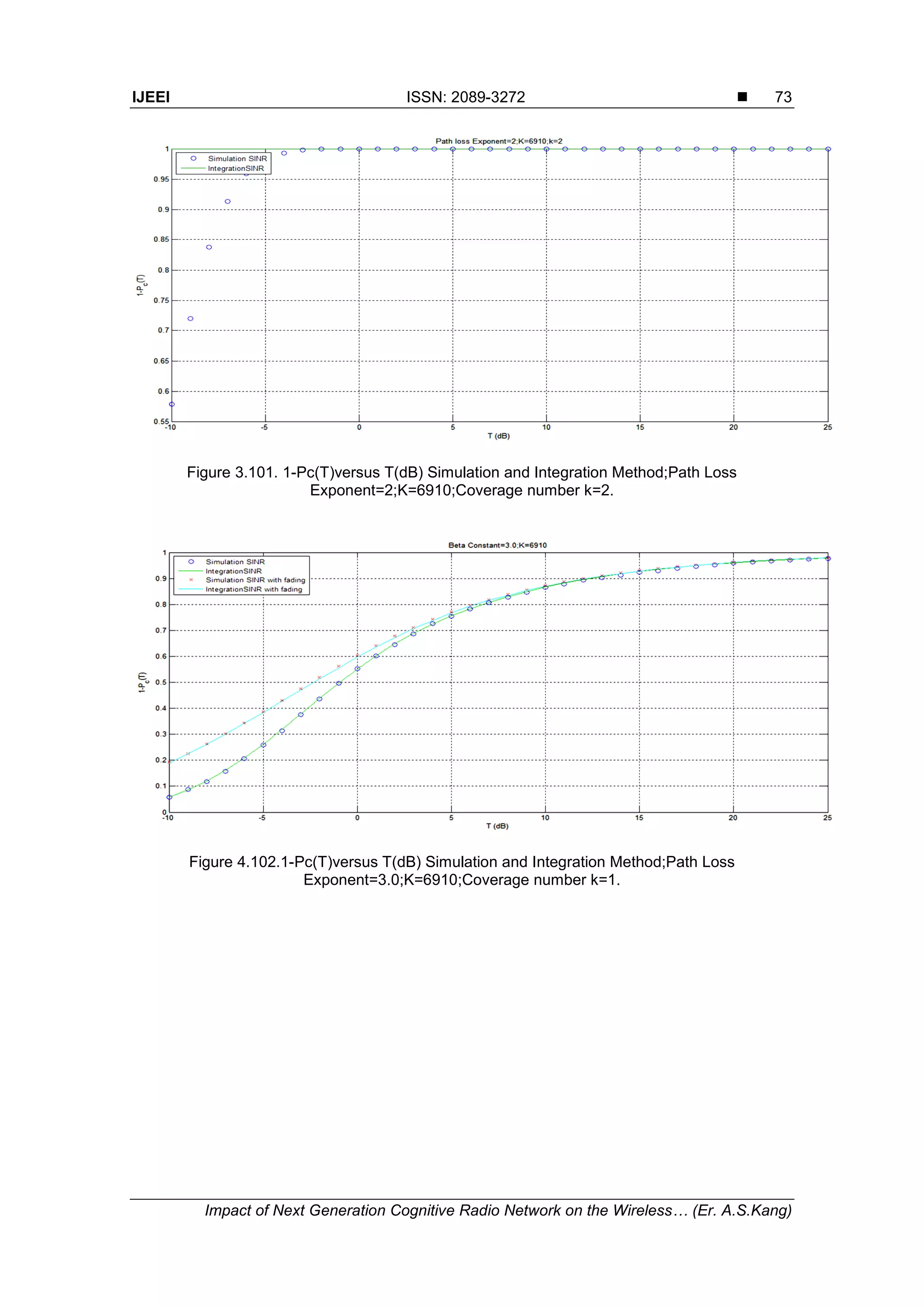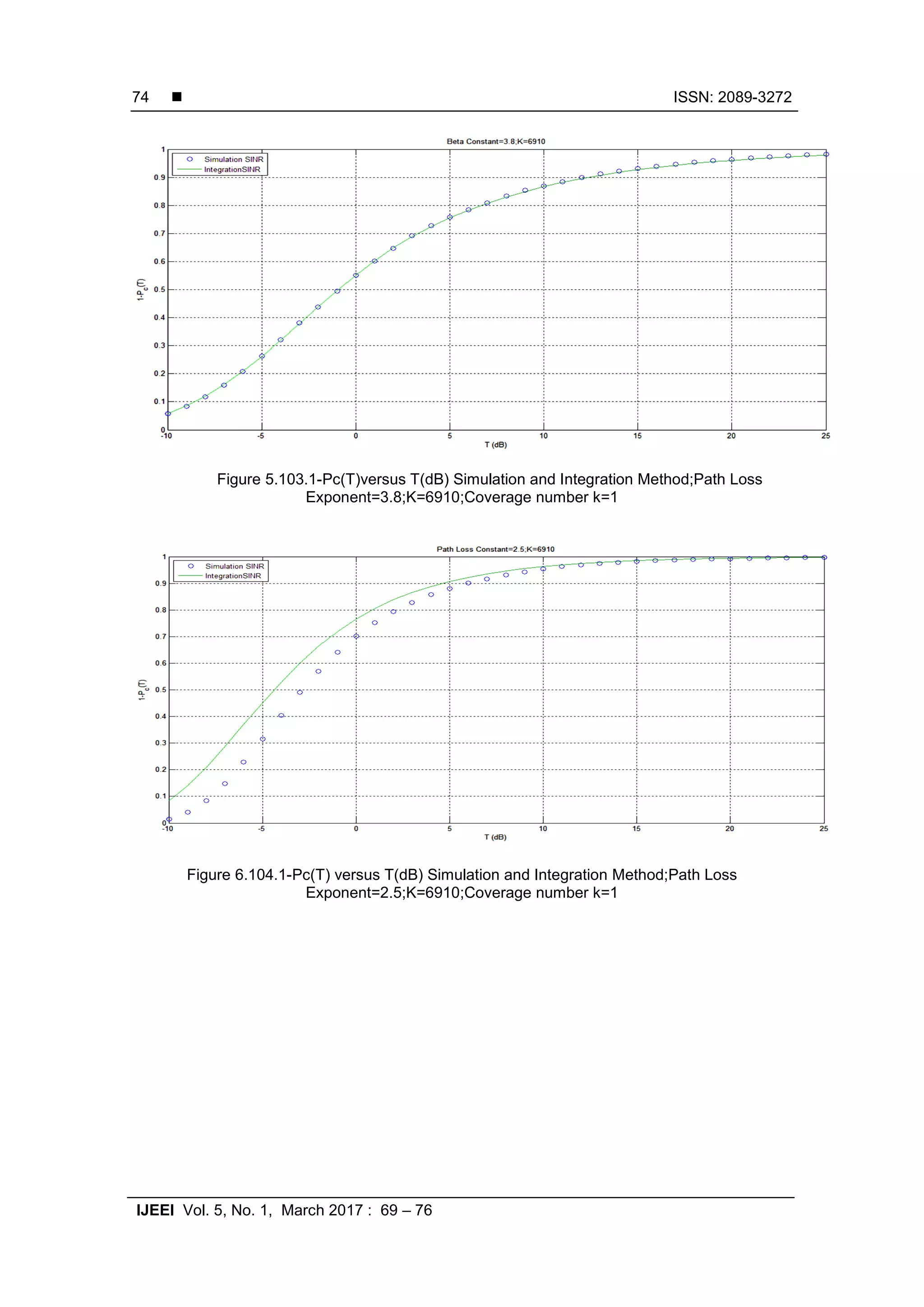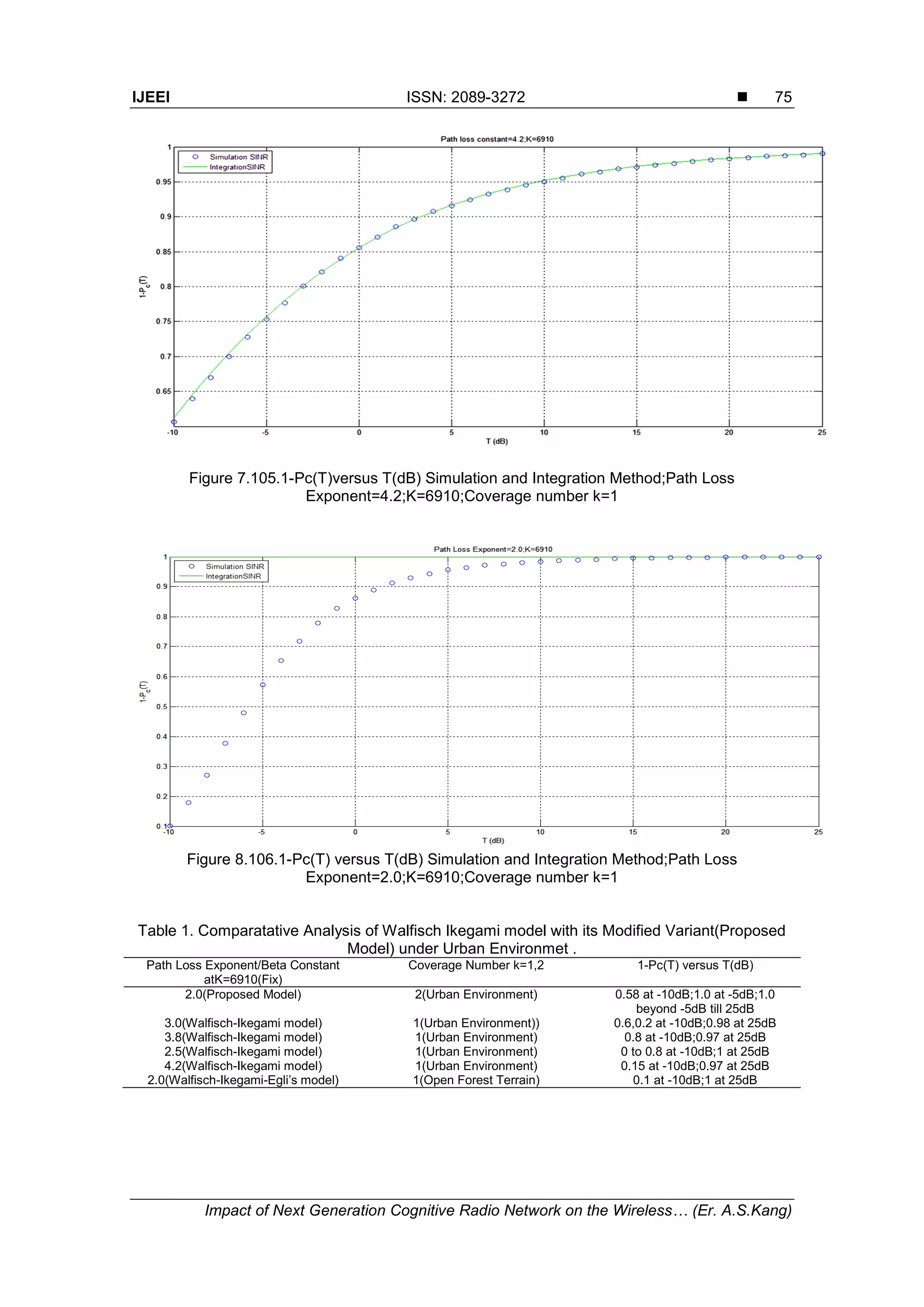The paper analyzes the impact of next-generation cognitive radio networks on the wireless green ecosystem through the study of signal and interference levels under shadow fading effects. It discusses various issues related to wireless sensor networks, path-loss laws, and presents a methodology for estimating coverage probability in such environments. Ultimately, it highlights the significance of 5G wireless cognitive radio technology for enhancing spectrum utilization and performance in mobile communication networks.
![Indonesian Journal of Electrical Engineering and Informatics (IJEEI)
Vol. 5, No. 1, March 2017, pp. 69~76
ISSN: 2089-3272, DOI: 10.11591/ijeei.v5i1.249 69
Received September 17, 2016; Revised January 20, 2017; Accepted February 12, 2017
Impact of Next Generation Cognitive Radio Network on
the Wireless Green Eco system through Signal and
Interference Level based K Coverage Probability
Er. A.S.Kang*, Renu Vig
UIET, Panjab University Chandigarh, India
e-mail: askang_85@yahoo.co.in
Abstract
Land mobile communication is burdened with typical propagation constraints due to the channel
characteristics in radio systems. Also, the propagation characteristics vary form place to place and also as
the mobile unit moves, from time to time. Hence, the tramsmission path between transmitter and receiver
varies from simple direct LOS to the one which is severely obstructed by buildings, foliage and terrain.
Multipath propagation and shadow fading effects affect the signal strength of an arbitrary Transmitter-
Receiver due to the rapid fluctuations in the phase and amplitude of signal which also determines the
average power over an area of tens or hundreds of meters. Shadowing introduces additional fluctuations,
so the received local mean power varies around the area –mean. The present paper deals with the
performance analysis of impact of next generation wireless cognitive radio network on wireless green eco
system through signal and interference level based k coverage probability under the shadow fading
effects.
Keywords: radio network, wireless cognitive radio network, signal.
1. Introduction
Wireless sensor networks (WSNs) consist of a large number of densely deployed
sensor nodes to monitor and track phenomenon or objects of interest in a specified region.
Sensor networks pose a number of challenging conceptual and optimization problems such as
localization,deployment and tracking [1-2].One of the fundamental problems in wireless sensor
networks relates to coverage which refers to how well sensors monitor or track the events.In
general, coverage can be considered as the measure of quality of service in a sensor
network.The coverage requirements may change after a network has been deployed due to
changes in the requirements of an application or environmental conditions[3].Sensing coverage
problem has been expressed as area coverage and point coverage. Different applications
require different degrees of sensing coverage; for example, some applications may require that
a location in a region be monitored by only one sensor, while other applications require
significantly higher number of sensors for the same [4].The most general way of defining
sensing coverage is to consider the ratio of sensing area to the area of interest,which means the
fraction of area that can be covered by the sensor network.The achievable sensing coverage
strongly depends on the node deployment planning.However, sensors should be deployed in
such a way that it should maximize the coverage and minimize the required number of
sensors.Planned node deployment is not always possible in some unstructured sensor network
applications like battlefield surveillance, forest monitoring, and so forth.Therefore, in such
applications,sensor nodes are randomly deployed to provide the required coverage.However, it
may be important to predict the minimum number of sensor nodes that provide an acceptable
level of coverage.Many of the sensor networks concentrate on detecting specific signals such
as thermal energy, acoustic signal, seismic signal,radio waves, light waves or magnetic field, in
the preferred sensing area [5].](https://image.slidesharecdn.com/08249-471-4-sm-171224035824/75/Impact-of-Next-Generation-Cognitive-Radio-Network-on-the-Wireless-Green-Eco-system-through-Signal-and-Interference-Level-based-K-Coverage-Probability-1-2048.jpg)
![ ISSN: 2089-3272
IJEEI Vol. 5, No. 1, March 2017 : 69 – 76
70
2. Path-loss law
Figure 1. 99 Average path loss versus distance in UHF bands as measured
in Northern Germany. (a, green): forest terrain; (b, orange): open area;
(grey): average of (a) and (b); (black): Egli's model[6]
These signals are affected by environmental factors like noise, interference, reflection of
signals, obstructions in the propagation path, and movement of other objects. Sensing signals
have extra power loss due to environmental factors besides path loss. This extra power loss
results into large deviations in the received signal strength. The deviation in the received signal
strength due to obstructions in propagation path is known as shadowing whereas deviation due
to reflections is known as multipath fading. The shadowing and multipath fading phenomena
adversely affect the quality sensing coverage [6].
3. Implications for Cognitive Radio Network Planning
If one extends the distinction between large-area and small-area shadowing, the
definition of shadowing covers any statistical fluctuation of the received local-mean power about
a certain area-mean power, with the latter determined by predictable large-scale mechanisms.
Multipath propagation is separated from shadow fluctuations by considering the local-mean
powers. That is, the standard deviation of the shadowing will depend on the geographical
resolution of the estimate of the area-mean power. A propagation model which ignores specific
terrain data produces about 12dB of shadowing. On the other hand, prediction methods using
topographical data bases with unlimited resolution can, at least in theory, achieve a standard
deviation of 0 dB. Thus, the standard deviation is a measure of the impreciseness of the terrain
description. If, for generic system studies, the large-scale path loss is taken of simple form
depending only on distance but not on details of the path profile, the standard deviation will
necessarily be large. On the other hand, for the planning of a practical network in a certain
known environment, the accuracy of the large-scale propagation model may be refined. This
may allow a spectrally more efficient planning if the cognitive-cellular layout is optimized for the
propagation environment. With shadowing, the interference power accumulates more
rapidly than proportionally with the number of signals. The accumulation of multiple signals with
shadowing is a relevant issue in the planning of cellular networks[7-8].
4. 5G Wireless Radio Network: Next Wave of Digital Society
The use of mobile communication networks has increased significantly in the past
decades, in terms of complexity of applications, their required capacities, and heterogeneity of
device types. So far, this trend has always been met by significant technological advancements
and will continue to increase. By 2020,Europe has to pave the way for a new generation of
converged wired and wireless communication networks, which has to be developed and
deployed to move forward to a future networked society. Here,we present our perspective on
such a 5G wireless cognitive radio access network and focus especially on the arising
challenges and new technologies that enable us to meet these challenges. Looking back at the
development of 3G (UMTS,HSPA) and 4G (LTE,LTE Advanced) it is clear that these](https://image.slidesharecdn.com/08249-471-4-sm-171224035824/75/Impact-of-Next-Generation-Cognitive-Radio-Network-on-the-Wireless-Green-Eco-system-through-Signal-and-Interference-Level-based-K-Coverage-Probability-2-2048.jpg)
![IJEEI ISSN: 2089-3272
Impact of Next Generation Cognitive Radio Network on the Wireless… (Er. A.S.Kang)
71
generations of mobile networks focused on creating new physical radio transmission schemes
in order to meet new capacity requirements. From our point of view,5G networks should
consider both wireless and wired parts targeting a fully integrated solution. Furthermore, in order
to address the user oriented challenges, we foresee a continued evolution of the existing
functions, e.g.network densification into ultradense networks and device to device
communications, as well as development of new functions such as moving(mobile) networks
and massive machine communications.5th generation mobile networks or wireless systems
denote the next major phase of mobile telecommunications standards beyond the
current 4G/IMT-Advanced standards.The Next Generation Mobile Networks Alliance defines 5G
network requirements as Data rates of several tens of Mb/s should be supported for tens of
thousands of users,1 Gbit/s to be offered, simultaneously to tens of workers on the same office
floor, Several hundreds of thousands of simultaneous connections to be supported for massive
sensor deployments, Spectral efficiency should be significantly enhanced compared to
4G.Coverage should be improved, Signaling efficiency could be enhanced[9].Hence,5G will
prove to be key wireless technology for the next generation cognitive radio communication
networks. Figureure5.100 shows the proposed wireless cognitive cellular radio network to check
the congested RF spectrum.
Figure 2.100 Proposed 5G Wireless Cognitive Radio Network[10].
5. Interference Management for CR Networks
A major issue in interference-tolerant CR networks in 5G is how to reliably and
practically manage the mutual interference of CR and primary systems. Regulating the transmit
power is essential for the CR system to coexist with other licensed systems. An interference
temperature model is introduced for this purpose to characterize the interference from the CR to
the licensed networks. Interference cancellation techniques should also be applied to mitigate
the interference at CR receivers. Another issue in interference-tolerant CR networks is that a
feedback mechanism is important to periodically inform the CR network about the current
interference status at the licensed system. A practical solution is that the interference state
information can be sent from licensed systems and collected by a central unit (or a third party
system).Any CR network should first register to the central unit in order to be updated regarding
the allowed spectrum and interference. Alternatively, the CR transmitters can listen to beacon
signals transmitted from the primary receivers and rely on the channel reciprocity to estimate
the channel coefficient. In this case, the CR transmitters can cooperate among themselves to
regulate the transmit power and prevent the interference at the primary receivers being above
the threshold [11].](https://image.slidesharecdn.com/08249-471-4-sm-171224035824/75/Impact-of-Next-Generation-Cognitive-Radio-Network-on-the-Wireless-Green-Eco-system-through-Signal-and-Interference-Level-based-K-Coverage-Probability-3-2048.jpg)
![ ISSN: 2089-3272
IJEEI Vol. 5, No. 1, March 2017 : 69 – 76
72
6. Coverage Probability Estimation under Shadow Fading Effect: Methodology
The coverage probability is the probability that such a ratio is above a given threshold.
In particular, we are interested in the probability that there is some antenna above threshold,
which provides a certain “gain”: if fading increases the Ec of some antenna, that not only
reduces the chance that other antennas are above threshold, by increasing I0, but it also, of
course, increases the chance that the given antenna is above threshold. We will derive an
expression for coverage probability that conservatively accounts for such gain. We can estimate
the coverage probability[12] that a location is uncovered, so that (I/Ek)>tkfor all k. Also,
I=η+∑jEj (1)
Assuming that tk=t, the desired probability is equal to
∏Prob{I > tEk I > t max Ej (j < k) (2)
Let Ik= η+∑Ej(j>k). The condition for given k implies that
t I=t ∑Ej +t Ek + t Ik< (k-1)I+ t Ek+ t Ik. so that I < [t/(t-k+1)](Ek+Ik) (3)
Further, we can use the estimate probability as
Prob{I > tEk I > t max Ej (j < k) (4)
<Prob{[t/(t-k+1)](Ek+Ik)>tEk,I>tmaxEj(j<k)}
≈ Prob{[t/(t-k+1)](Ek+Ik)>tEk
= Prob{(Ik/Ek) > t-k}
7. Simulation Results and Discussion
Here we have calculated and plotted SINR-based probability of k-coverage via
simulation of model and integration method and compared our results with those obtained by
H.P. Keeler, Inria Paris/ENS,2013[13]. Here the performance parameters which have been
taken under consideration are base station density represented by lambda=0.2887/2; In this
comparatative Simulation Study, K and betaConst values correspond to Walfisch-Ikegami model
for a urban environment where betaConst=4.2 is nothing but path-loss exponent and K=6910.
The log normal parameters which have been used are sigmDb=10; sigma=sigmDb/10*log(10);
ESTwoBeta=exp(sigma^2*(2-betaConst)/betaConst^2); The model constant incorporates the
model parameters as stated in equation below.
a=lambda*pi*ESTwoBeta/K^2;
While the noise parameters are helpful in calculating W.N=10^(-96/10)/1000;
P=10^(62.2/10)/1000; W=N/P; In this entire process, the SINR threshold values which have
been taken are as follows
tMinDb=-10;tMaxDb=25;tValuesDb=(tMinDb:tMaxDb)';
(values in dB), tValues=10.^(tValuesDb/10); tNumb=length(tValues); while the coverage
number has been varied from 1 to 2.k=1; To achieve the analytic/integration results, we have
made the usage of following function.
numbMC=10^3;PCov=funProbCov(tValues,betaConst,W*a^(-betaConst/2), numbMC,k);
Ultimately, the Simulation section shows the results which are there obtainable after
incorporating fading environment effect. simNumb=10^4;%number of simulations;
diskRadius=20; PcovSim = funSimLogNormProbCov (tValues, betaConst, K, lambda, sigma, W,
diskRadius, simNumb, k); The results are plotted by using the commands namely Pn=1–Pcov;
PnSim=1-PCovSim; plot(tValuesDb, PnSim, 'o', tValuesDb, Pn); grid; legend
(['Simulation',legendLabel], ['Integration', legendLabel], xlabel('T(dB)'); ylabel('1-P_c(T)')](https://image.slidesharecdn.com/08249-471-4-sm-171224035824/75/Impact-of-Next-Generation-Cognitive-Radio-Network-on-the-Wireless-Green-Eco-system-through-Signal-and-Interference-Level-based-K-Coverage-Probability-4-2048.jpg)



![ ISSN: 2089-3272
IJEEI Vol. 5, No. 1, March 2017 : 69 – 76
76
8. Conclusion
All the tabulated results have been presented after their validation and comparatative
analysis with modified Walfisch-Ikegami model variants at fix K=6910 but variable coverage
probability number k(1,2)Beyond k=2 the trend in results changes drastically with 1-
Pc(T)=0.75(Constant) from -10db to 25dB(Threshold).5G Cognitive Radio Network is an
innovative SDR technique which has been considered as one of the promising technologies to
improve the utilization of congested RF Spectrum.Adopting CR is motivated by the fact that a
large portion of spectrum is underutilized most of the time[14-16].
References
[1] Akyildiz IF, Su W, Sankarasubramaniam Y, Cayirci E. A survey on sensor networks. IEEE
Communications Magazine. 2002; 40(8): 102–114.
[2] Hossain A, Biswas PK, Chakrabarti S. Sensing models and its impact on network coverage in
wireless sensor network. Proceedings of the IEEE Region 10 Colloquium and 3rd International
Conference on Industrial and Information Systems (ICIIS '08); India. 2008: 1–5.
[3] Zaho F, Guibas L. Wireless Sensor Networks: An Information Processing Approach. Elsevier. 2004.
[4] Bereketli A, Akan OB. Communication coverage in wireless passive sensor networks. IEEE
Communications Letters. 2009; 13(2): 133–135.
[5] Mao G, Anderson BDO, Fidan B. Path loss exponent estimation for wireless sensor network
localization. Computer Networks. 2007; 51(10): 2467–2483.
[6] Zhu C, Zheng C, Shu L, Han G. A survey on coverage and connectivity issues in wireless sensor
networks. Journal of Network and Computer Applications. 2012; 35(2): 619–632.
[7] Wang X, Xing G, Zhang Y, Lu C, Pless R, Gill C. Integrated coverage and connectivity configuration
in wireless sensor networks. Proceedings of the 1st International Conference on Embedded
Networked Sensor Systems (SenSys '03). New York. 2003: 28–39.
[8] Xing G, Wang X, Zhang Y, Lu C, Pless R, Gill C. Integrated coverage and connectivity configuration
for energy conservation in sensor networks. ACM Transactions on Sensor Networks. 2005; 1(1): 36–
72.
[9] 5G White Paper - Executive Edition by NGMN Alliance.
[10] Cheng-Xiang Wang, Fourat Haider et al. Cellular Architecture and Key Technologies for 5G Wireless
Communication Networks. IEEE Communications Magazine. 2014: 122-130.
[11] Kenneth L.Clarkson, John D.Hobby. A Model of Coverage Probability under Shadow Fading. IEEE
Transactions on Communication. 2003: 11.
[12] www.googlescholar.com.
[13] HP Keeler and Inria. Paris,2013. Walfisch-Ikegami Model. www.mathworks.com
[14] AS Kang. Analysis of Noisy Fading Channel under strategic conditions. Proc. International
Conference on Next Generation & Computing. Institution of Engineers, Technocrats, Academician.
Network. 2010: 330-335.
[15] AS Kang, Renu Vig. Simulation Analysis of Modified Filter Bank Multicarrier for Physical Layer
Cognitive Radio under Radio Environment. Invertis Journal of Science and Technology. 2014; 7(4):
214.
[16] AS Kang, Renu Vig. Computer Aided BER Performance Analysis of FBMC Cognitive Radio for
Physical Layer under the Effect of Binary Symmetric Radio Fading Channel. SPRINGER-Journal of
Wireless Personal Communications. 2015; 81(2): 15.](https://image.slidesharecdn.com/08249-471-4-sm-171224035824/75/Impact-of-Next-Generation-Cognitive-Radio-Network-on-the-Wireless-Green-Eco-system-through-Signal-and-Interference-Level-based-K-Coverage-Probability-8-2048.jpg)